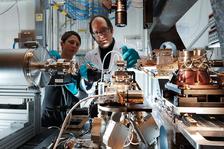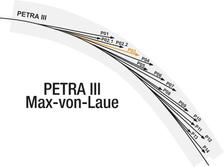P03 is the micro and nanofocus small- and wide-angle X-ray scattering (SAXS/WAXS/USAXS/GISAXS/GIWAXS/GIUSAXS) beamline (MiNaXS) at PETRA III. This beamline exploits the excellent photon beam properties of the low emittance source PETRA III to provide micro- and nanofocused beams with ultra-high intensity and resolution in real and reciprocal space.
P03 is the micro and nanofocus small- and wide-angle X-ray scattering beamline (MiNaXS) at PETRA III. Due to its high flexibility to handle different sample environments, it is covering a variety of scientific domains such as sustainable energy, health, information technology, earth and environment, transportation technology etc. to solve major challenges. It is an ideal platform for studying nanostructures and dynamics under in vivo and in situ /operando conditions. P03 is offering unique characterization possibilities to the users – possibility to do combined real-time x-ray scattering investigations on different time and length scales.
The MiNaXS beamline exploits one of a high-β canted 2 m undulator pairs. The energy range of the beamline is 7 – 21 keV. In combination with large-offset Si(111) crystals as monochromator, this demands a very high stability and precise positioning. To suppress higher harmonics, a planar double-mirror with low incidence angle compatible with the large energy range of the beamline is used.
The beamline offers dedicated micro- and nano-focus endstations being both dedicated to transmission as well as grazing incidence experiments. The details of the two end stations are as follows:
- The beam dimensions of the microfocus end station (hutch EH1) are 42 x 20 μm2 and 22 x 13 μm2, which corresponds perfectly with the design values.
- Additionally, a 1:1 imaging layout for combining USAXS (Ultra Small-Angle X-ray Scattering) with a moderately microfocused beam can be used.
- A variety of sample environments is offered at the microfocus end station
- The Nanofocus Endstation (hutch EH2), constructed within a BMBF-funded project by Kiel University (Prof. Martin Müller), is now operated by Helmholtz-Zentrum Geesthacht in cooperation with Kiel University and DESY. Optics for nanofocusing include KB-mirror, waveguides, and compound refractive lenses. The minimum beam size is currently 250 nm by 350 nm and a long focal distance optics is used to provide a clear working distance of up to 8 cm.
- The experimental techniques at the Nanofocus Endstation have a strong focus on materials science and the long working distance is an excellent setting for extended in situ sample environments (such as high pressure, nanoindentation, tension, electric / magnetic fields).
Before submitting an application, the users are strongly advised to contact the beamline scientists and clarify the technical feasibility and availability status of the equipment. In some cases, feasibility tests can be organized.
Data analysis coping with the high data rates is crucial. The software package DPDAK - jointly developed and operated by DESY and MPI Golm - allows for online analysis of the GISAXS/SAXS/GIWAXS/WAXS data.
For further documentation of the MiNaXS beamline, please refer to Beamline Manual
Any questions or suggestions, please do not hesitate to contact the beamline staff.








